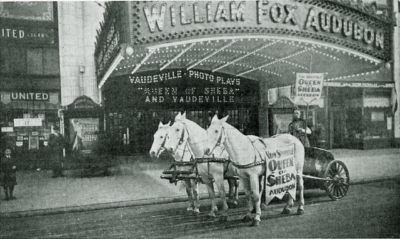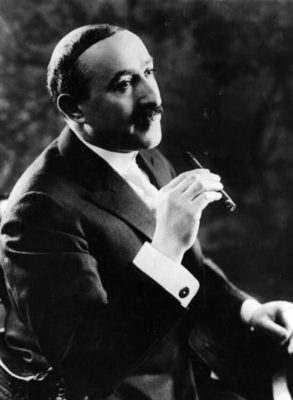 Disney’s acquisition of 21st Century Fox isn’t expected to be completed until sometime in 2019. But in this edition of Getting to Know You, we begin looking at the company’s humble beginnings. The studio is often colloquially known simply as “Fox” and its namesake is William Fox. What many modern moviegoers don’t know is that before there was 20th Century Fox, there was Fox Film Corporation; and it all began with William Fox.
Disney’s acquisition of 21st Century Fox isn’t expected to be completed until sometime in 2019. But in this edition of Getting to Know You, we begin looking at the company’s humble beginnings. The studio is often colloquially known simply as “Fox” and its namesake is William Fox. What many modern moviegoers don’t know is that before there was 20th Century Fox, there was Fox Film Corporation; and it all began with William Fox.
Born in 1879, William Fox started life as Vilmos Fried in Tolcsva, Hungary. His parents emigrated to New York City when he was just nine months old and like Walt, he worked as a newsboy when he was young. Entering adulthood, he legally changed his name to William (which sounded enough like Vilmos – pronounced “Wilhelm”). For his new last name, he was inspired by his mother’s maiden name Fuchs, pronounced “Fox.”
William Fox was 21-years-old when he began his first business in 1900 after working in the garment industry. By 1904 he began acquiring Nickelodeons throughout New York and used the profits to expand his ownership to movie and vaudeville theaters. He found great success by pairing vaudeville performers with movies and his theater empire began to expand, with Fox personally overseeing construction of his theaters all the way to the west coast.
When theater profits began to wane, William Fox became a film distributor to save his theaters. He founded the Greater New York Film Rental Company, through which he would buy films from studios and distribute them to theaters, his own and others as well. When Hollywood studios fought back by forming their own similar entity, the Motion Pictures Patent Company, Fox sued the monopoly and won. By 1914, Fox’s distribution company was renamed the Box Office Attraction Film Rental Company and among the films distributed was Windsor McCay’s Gertie the Dinosaur, which had a great impact on a young Walt Disney.
The Fox Film Corporation began in 1915 in a rental studio in New Jersey. A rental production facility followed shortly after in Los Angeles, CA, and by 1916, the studio had found a permanent home at the intersection of Sunset Boulevard and Western Avenue. In 1919, Fox Newsreel began delivering the news with the silent films the company produced.
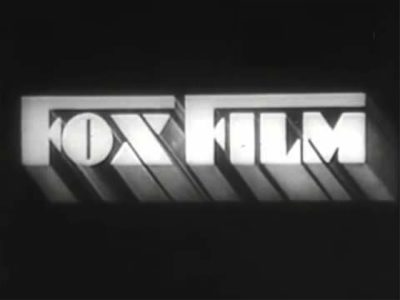 Warner Bros. was the first Hollywood studio to release a “talkie” with The Jazz Singer in 1927, but Fox began investing and buying the technology for sound-on-film as early as 1925. Warner’s product utilized a synchronized disc, allowing the sound to get out of sync. Fox was quick to follow with one of the first films to feature synchronized sound on the film itself later that same year. Sunrise used Fox’s Movietone Sound System and at the first ever Academy Awards in 1929, Sunrise won Best Unique & Artistic Picture as well as Best Actress for Janet Gaynor.
Warner Bros. was the first Hollywood studio to release a “talkie” with The Jazz Singer in 1927, but Fox began investing and buying the technology for sound-on-film as early as 1925. Warner’s product utilized a synchronized disc, allowing the sound to get out of sync. Fox was quick to follow with one of the first films to feature synchronized sound on the film itself later that same year. Sunrise used Fox’s Movietone Sound System and at the first ever Academy Awards in 1929, Sunrise won Best Unique & Artistic Picture as well as Best Actress for Janet Gaynor.
The advent of sound in film created the need for the “soundstage,” and thus William Fox bought another plot of land in Hollywood to establish Movietone City, the site of the current 20th Century Fox Studios. 1927 also brought about the passing of Marcus Leow (the namesake of Leow’s Theaters), who also had a controlling interest in MGM. William Fox made a bid to purchase Leow’s business holdings from his family and they consented to the sale. When the acquisition was announced in 1929, MGM studio head Louis B. Mayer fought back, using his connections in Washington to block the sale.
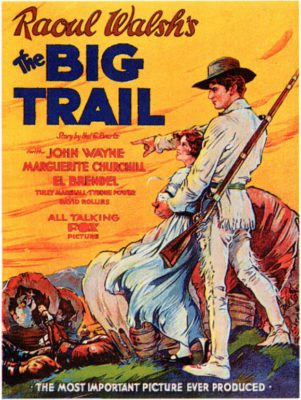 1929 would cripple William Fox, both financially and personally. That summer, a car crash left him hospitalized and by the time his body had recovered, his finances had taken a dive. The failed attempt to acquire Leows on top of the dawning of the Great Depression put William Fox nearly $100 million in debt in 1920’s dollars. He would spend the better part of the next decade trying to fight bankruptcy. The last film he personally produced was 1930’s The Big Trail, which utilized the first widescreen film process (70 mm Fox Grandeur) and the first starring role for a young John Wayne.
1929 would cripple William Fox, both financially and personally. That summer, a car crash left him hospitalized and by the time his body had recovered, his finances had taken a dive. The failed attempt to acquire Leows on top of the dawning of the Great Depression put William Fox nearly $100 million in debt in 1920’s dollars. He would spend the better part of the next decade trying to fight bankruptcy. The last film he personally produced was 1930’s The Big Trail, which utilized the first widescreen film process (70 mm Fox Grandeur) and the first starring role for a young John Wayne.
To settle the debt to Leow’s from the failed acquisition, William Fox transferred ownership of all of his theaters in 1930. Fox Film Corporation was left under the leadership of Sidney Kent and the company also filed for bankruptcy by 1932. In 1935, Kent would enter an agreement with an independent startup called 20th Century to help save the studio, which will be the subject of the next edition of Getting to Know You.
Sadly, many of the Fox films from the days of William Fox are considered lost. The negatives were housed in a film vault in New Jersey and in 1937, one of the highly flammable nitrate film reels spontaneously combusted, igniting the entire vault and destroying the negatives. It is estimated that at least 70% of Fox’s films were destroyed in the fire and many of the earliest Fox films still in existence were reconstructed from lower quality elements, such as used copies distributed to theaters or international work prints.
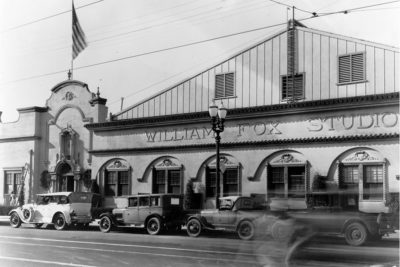
Finishing William Fox’s sad story, he would eventually sell off most of the film patents he owned, such as those for the Movietone sound system, in his attempt to become debt solvent. At a 1936 bankruptcy hearing, he attempted to bribe the judge and earned 6-months in prison. Upon release, he attempted to reenter Hollywood, but was blocked by the newly established Hayes Code since he was now a convicted felon.
William Fox passed away in 1952 and headlines referred to him as “The Film Industry’s Forgotten Man.” However, that statement is not quite true. After all, over 100 years after Fox Film Corporation began, we still refer to 21st Century Fox in casual conversation as simply, “Fox.” None of that would have been possible without the entrepreneurial spirit of William Fox.
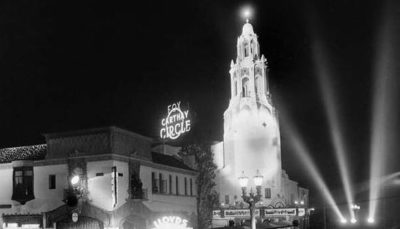 Ending on a happy note, one of William Fox’s movie theaters holds a special place in Disney history. Fox’s Carthay Circle Theater in Hollywood was the auspicious location of the world premiere of Walt Disney’s Snow White and the Seven Dwarfs, as well as one of only twelve theaters to be outfitted with Fantasound for the 1940 release of Fantasia. While the original theater no longer exists, Guests at Disney Parks can relive the golden era of Hollywood at both Disneyland and Walt Disney World. The theater is the icon of Disney California Adventure, where it houses a restaurant and the exclusive 1901 lounge, an extension of Club 33. At Disney’s Hollywood Studios it’s a little less conspicuous, merely a gift shop on Sunset Boulevard in the shadows of the Hollywood Tower Hotel. With Disney set to own the company started by William Fox, it becomes even more fitting that one of his original theaters is forever in the hearts of Disney fans.
Ending on a happy note, one of William Fox’s movie theaters holds a special place in Disney history. Fox’s Carthay Circle Theater in Hollywood was the auspicious location of the world premiere of Walt Disney’s Snow White and the Seven Dwarfs, as well as one of only twelve theaters to be outfitted with Fantasound for the 1940 release of Fantasia. While the original theater no longer exists, Guests at Disney Parks can relive the golden era of Hollywood at both Disneyland and Walt Disney World. The theater is the icon of Disney California Adventure, where it houses a restaurant and the exclusive 1901 lounge, an extension of Club 33. At Disney’s Hollywood Studios it’s a little less conspicuous, merely a gift shop on Sunset Boulevard in the shadows of the Hollywood Tower Hotel. With Disney set to own the company started by William Fox, it becomes even more fitting that one of his original theaters is forever in the hearts of Disney fans.
Other articles in the Getting to Know You series

